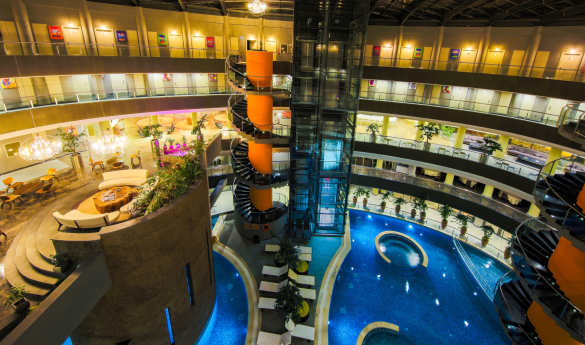Pamukkale
Pamukkale, in southwest Turkey, is best known for its gleaming white calcite shelves, or terraces, overrunning with warm, mineral-rich waters. The highly photogenic and brilliant white terraces, with their naturally heated pools, are an otherworldly natural wonder. Nearby, are the must-visit archaeological sites of Afrodisias and Hierapolis.
Read more
Granted Unesco World Heritage status, Pamukkale is a natural site with dazzling white petrified lime cascades, located in Denizli, southwest Turkey. It was formed when a fault in the valley shifted and hot springs, with a high mineral content, rose up. Today, it is Turkey’s single most visited attraction. Visitors come to admire the ‘Cotton Castle' (pamuk means 'cotton' in Turkish), which plunges down the mountainside, above the river, creating a stunning and dazzling natural formation. Since Roman times, the thermal water has been noted for its therapeutic powers.
Natural beauty aside, Pamukkale’s well-preserved Roman ruins, as well as the ancient Greek Hellenistic city of Afrodisias and the ruins of Hierapolis, are all also very much worth visiting.
A UNESCO site, Afrodisias is a fascinating archaeological site devoted to the Greek goddess of love, with striking marble sculptures and facades. Most notable is the Temple of Aphrodite, built by the order of Emperor Zeno, as well as a sanctuary for worship of the Roman emperor.
Nearby Hierapolis, whose name translates as ‘sacred city’, is an archaeological site blending Roman, Jewish, pagan and early Christian influences. Mentioned in the Bible, it has been used as a spa since 2nd century BC. The highlight is the Roman amphitheatre here, with no less than of 12,000 seats, and the spectacular views of the white terraces of Pamukkale.
Read moreWhy Scott Dunn for Pamukkale Holidays?
Unique to You

- We listen to your travel goals and craft unique trips that are bespoke to you.
- We’re with you every step of your life’s travel journey, from honeymoons to family trips and beyond.
Seamless Service

- Global offices in the UK, US, and Singapore for 24/7 seamless service.
- We offer flexibility if your plans change so you can book with confidence and peace of mind.
Carefully Curated Collection

- We’ve curated an elevated collection of accommodation, experiences, and guides.
- Committed to fostering close global relationships to continue bringing you unique experiences.
Luxury in Every Sense

- We deliver a sense of luxury that matters most to you.
- Awarded Condé Nast Traveller’s Top Travel Specialists in the World 12 years in a row.
